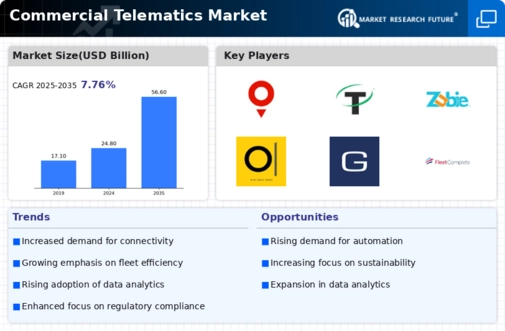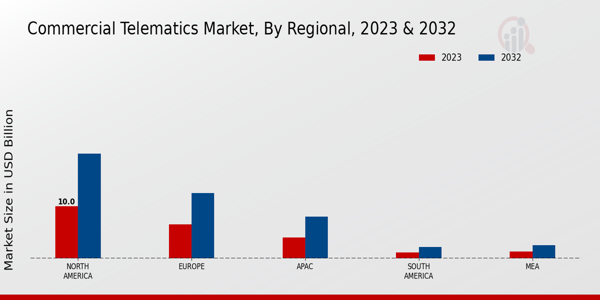Rising Focus on Sustainability
Sustainability is becoming an increasingly prominent driver within the Global Commercial Telematics Market Industry, as organizations strive to reduce their carbon footprint and enhance environmental responsibility. Telematics solutions enable companies to monitor fuel consumption, optimize routes, and implement eco-friendly driving practices. For instance, businesses that adopt telematics report a reduction in greenhouse gas emissions by up to 15 percent. This growing emphasis on sustainability aligns with global efforts to combat climate change, prompting more companies to invest in telematics technologies. As sustainability initiatives gain traction, the demand for telematics solutions is expected to rise, contributing to market expansion.
Advancements in IoT and Connectivity
The Global Commercial Telematics Market Industry is significantly influenced by advancements in Internet of Things (IoT) technology and connectivity solutions. The integration of IoT devices in vehicles allows for real-time data collection and analysis, enabling businesses to make informed decisions regarding fleet operations. Enhanced connectivity through 5G networks further facilitates seamless communication between vehicles and telematics systems. This technological evolution is expected to drive market growth, as companies seek to leverage data analytics for predictive maintenance and operational optimization. The increasing reliance on connected devices is likely to reshape the telematics landscape, fostering innovation and efficiency.
Chart Representation of Market Growth
The Global Commercial Telematics Market Industry is poised for substantial growth, as illustrated in the accompanying charts. The market is projected to reach a value of 24.8 USD Billion in 2024, with a significant increase anticipated to 56.6 USD Billion by 2035. The compound annual growth rate of 7.78% from 2025 to 2035 highlights the robust expansion expected in this sector. These visual representations underscore the upward trajectory of the market, reflecting the increasing adoption of telematics solutions across various industries.
Regulatory Compliance and Safety Standards
Regulatory compliance is a critical driver for the Global Commercial Telematics Market Industry, as governments worldwide implement stringent safety and environmental regulations. These regulations necessitate the use of telematics solutions to ensure adherence to standards such as driver behavior monitoring and vehicle emissions tracking. For example, the European Union has mandated the installation of tachographs in commercial vehicles to monitor driving hours and rest periods. This regulatory landscape compels companies to invest in telematics systems, thereby propelling market growth. The increasing focus on safety and compliance is likely to enhance the adoption of telematics solutions across various sectors.
Increasing Demand for Fleet Management Solutions
The Global Commercial Telematics Market Industry is witnessing a surge in demand for fleet management solutions, driven by the need for enhanced operational efficiency and cost reduction. Companies are increasingly adopting telematics systems to monitor vehicle performance, optimize routes, and reduce fuel consumption. For instance, businesses utilizing telematics report an average fuel savings of 10 to 15 percent. This trend is expected to contribute to the market's growth, with projections indicating a market value of 24.8 USD Billion in 2024, and a potential increase to 56.6 USD Billion by 2035, reflecting a compound annual growth rate of 7.78% from 2025 to 2035.

















Leave a Comment